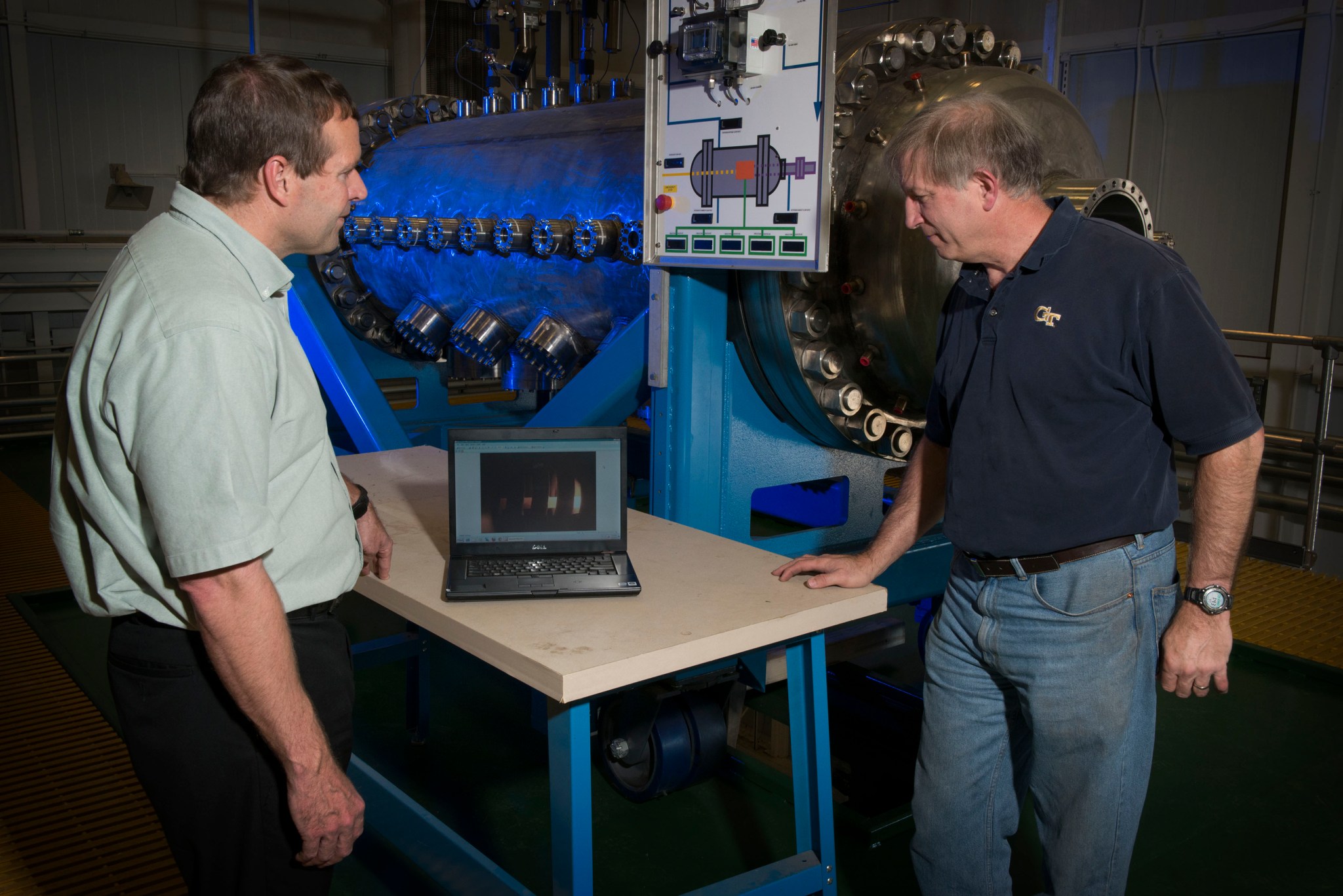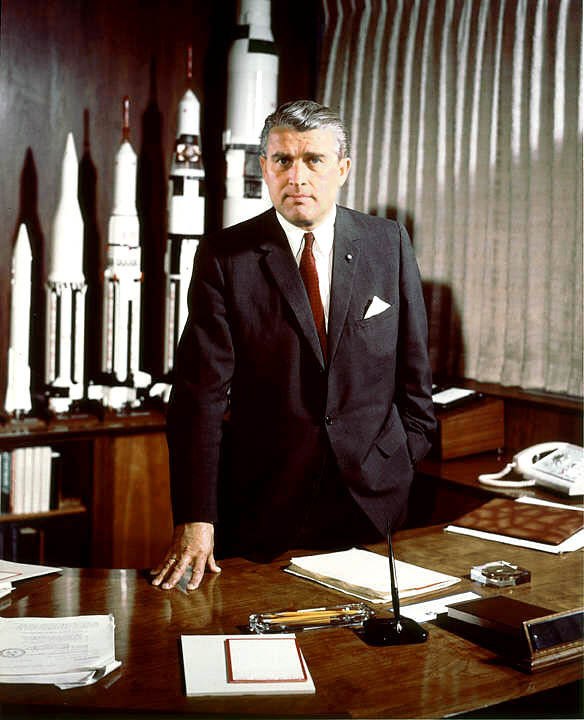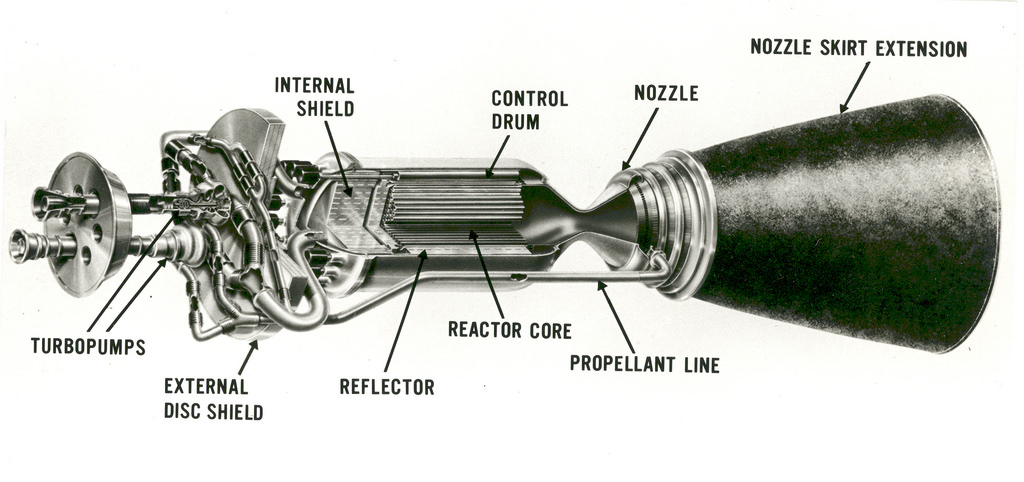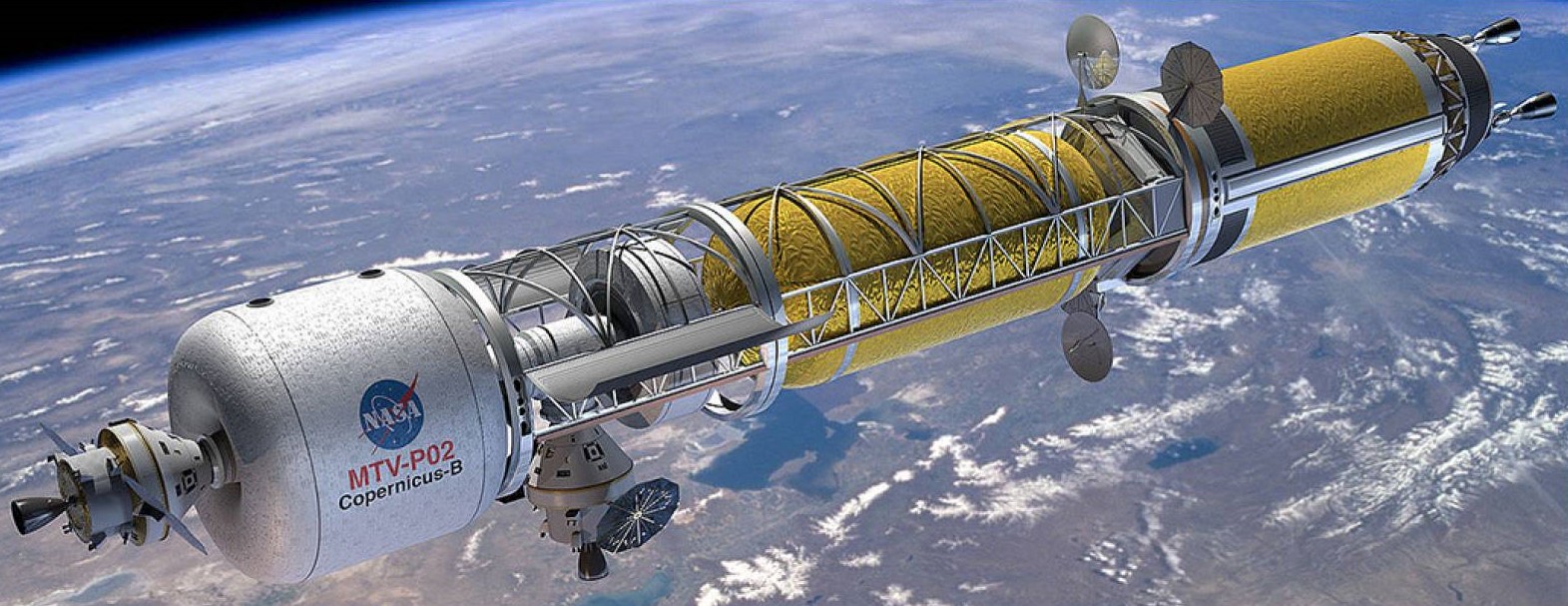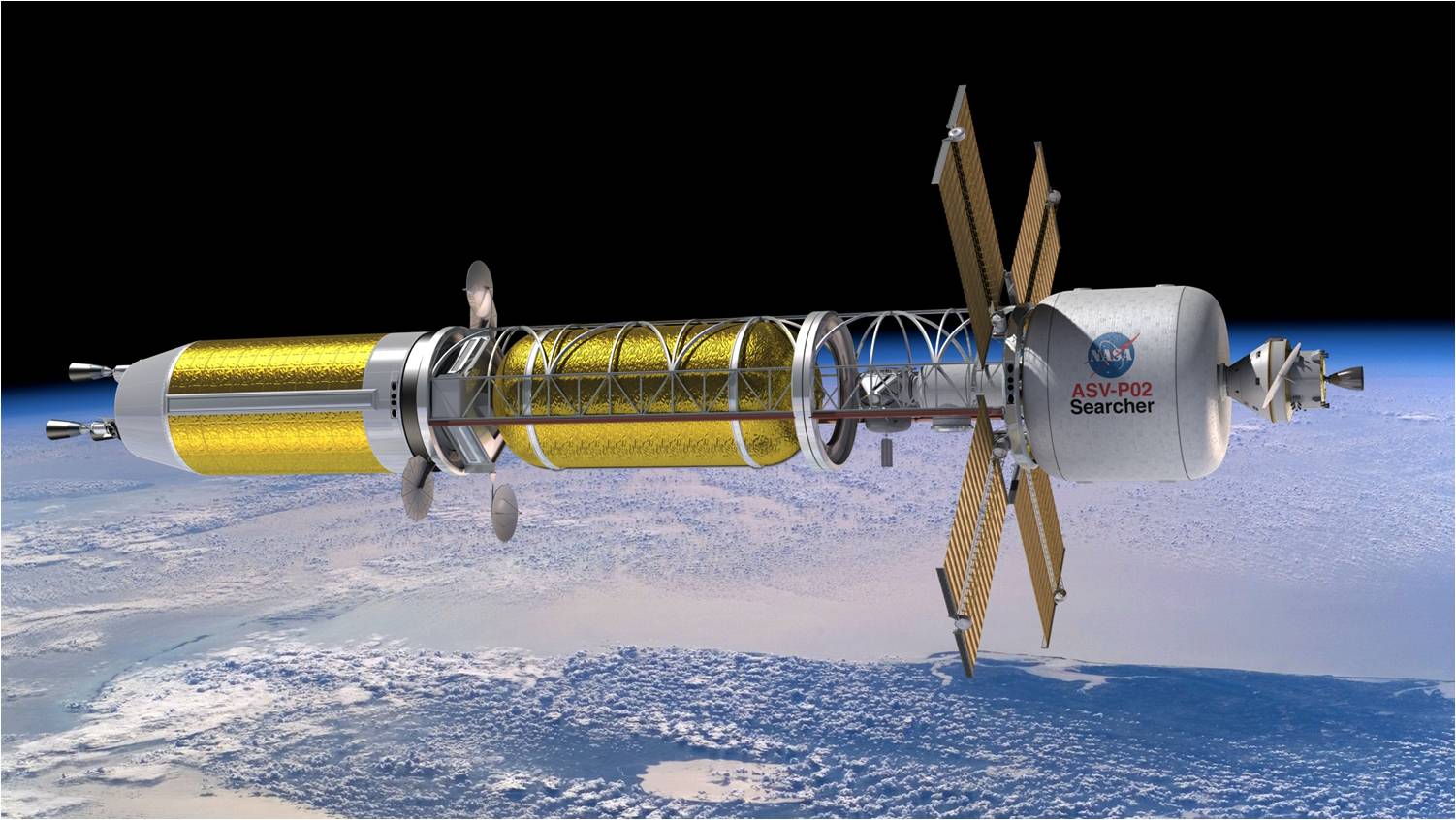Today’s advances in materials, testing capabilities, and reactor development are providing impetus for NASA to appraise Nuclear Thermal Propulsion (NTP) as an attractive 21st century option to propel human exploration missions to Mars and other deep space destinations.
Utilizing nuclear technology as an ingredient of NASA’s exploration prowess is not new. NTP research is part of the space agency’s storied history. In 1961, NASA and the former Atomic Energy Commission jointly embarked on the Nuclear Engine for Rocket Vehicle Application (NERVA) program – an effort that over several years led to the design, building, and testing of reactors and rocket engines.
Those programmatic high points spurred then-NASA Marshall Space Flight Center director and rocket pioneer, Wernher von Braun, to advocate for a proposed mission, dispatching a dozen crew members to Mars aboard two rockets. Each rocket would be propelled by three NERVA engines. As detailed by von Braun, that expeditionary crew would launch to the Red Planet in November 1981 and land on that distant world in August 1982. In presenting his visionary plan in August 1969 to a Space Task Group, von Braun explained that “although the undertaking of this mission will be a great national challenge, it represents no greater challenge than the commitment made in 1961 to land a man on the moon.”
But shifting priorities, political winds and space budget cutbacks led to curtailment of NASA’s nuclear propulsion work at the end of 1972.
Architectural robustness
Now, fast forward over 45 years ago to today. There is once again recognition that NTP is a viable and powerful option to explore Mars and other destinations.
“We’re working on a first generation NTP system that has great growth potential,” explains Doyce “Sonny” Mitchell, manager of the NTP project at NASA’s Marshall Space Flight Center in Huntsville, Alabama. NTP is experiencing a renewed relevance, a new focus on “architectural robustness,” he adds.
Mitchell says that NTP advanced systems could provide far faster transit times to Mars.
Potential advantages of NTP for human Mars missions include reduced transit time to the planet and back to Earth. Getting back and forth in speedy fashion between planets also reduces astronaut exposure to radiation and other hazards, including the impact on the human body of exposure to microgravity. First generation NTP systems could cut total mission duration in half, while still leaving adequate time for Mars surface exploration.
In addition, using NTP provides a plus for flight planners that must consider potential abort scenarios, Mitchell notes, “and that gives you margins, something we all like.”
With NTP, missions to Mars could be achieved at times when Earth and the Red Planet are in less favorable orbital positions relative to each other.
All that said, energetic NTP yields exceptional efficiency, measured in space-speak as “specific impulse” – the change in momentum per unit mass of propellant. NTP offers enhanced energy density, far greater than that of customary chemical systems. It becomes feasible to quickly bridge the intervening vacuum void between Earth and Mars.
New approaches
Recent advances in materials technology may provide a more affordable pathway to development of a nuclear rocket engine, suggests Michael Houts, the NTP principal investigator on the project at NASA Marshall. For decades, a range of nuclear propulsion system designs have involved reactors fueled by highly enriched uranium.
“Now we’re looking at systems that use low-enriched uranium,” Houts points out. One key benefit of this approach is that using low-enriched uranium may allow established rocket engine test facilities to be modified for use in qualifying NTP systems.. Systems for capturing all potentially radioactive effluents from ground testing are also being developed and demonstrated, further increasing flexibility in test site location.
Secondarily, using low-enriched uranium could be less impactful on budget and schedule due to the reduction of handling and security regulations, Houts observes. “Those two items can be very beneficial for our NTP work.”
The overall goal of the NTP project, Mitchell notes, is to determine the viability and affordability of a low enriched uranium-based NTP engine.
Past NERVA research found that graphite composite fueled engines exhibited unwanted erosion and cracking. Therefore, the push to appraise a candidate ceramic-metallic fuel form is a key focus for the new NTP initiative.
Fuel fabrication
BWXT Nuclear Energy, Inc., headquartered in Lynchburg, Virginia is working with NASA on initial reactor conceptual trades and designs, initial fuel and core fabrication development, licensing support for initial ground testing, and engine test program development.
“It is an opportune time to pivot our capabilities into the space market where we see long-term growth opportunities in nuclear propulsion and nuclear surface power,” says Rex Geveden, BWXT’s President and Chief Executive Officer. Manufacturing the reactor and fuel for a nuclear-powered spacecraft is one example.
NTP fuel is currently being developed and fabricated by BWXT. Fuel samples are undergoing non-nuclear testing in NASA’s Compact Fuel Element Environmental Tester (CFEET) at NASA’s Marshall Space Flight Center in Huntsville, Alabama, helping to validate fabrication techniques and performance, Houts notes.
Non-nuclear testing of full-length fuel segments is planned for NASA’s Nuclear Thermal Rocket Element Environmental Simulator (NTREES), and potential follow-on projects may include fuel element testing at a Department of Energy facility, such as Idaho National Laboratory’s Transient Reactor Test Facility.
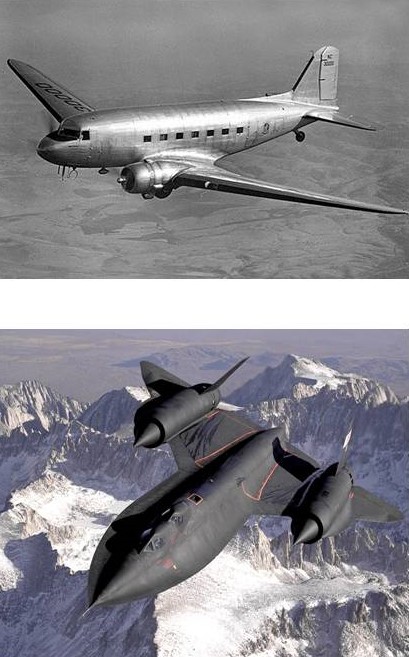
Full utilization of NTP systems will also require an engine ground test facility. One option under review is use of the NASA’s Stennis Space Center’s A3 test stand to fully confine the hydrogen exhaust, and other options are being considered as well. Stennis is currently on track for a 2019 subscale demonstration of NTP exhaust capture, NASA’s Houts says. “There is a lot of work underway. We’re advancing at a good rate.”
Opening up the solar system
Tackling the NTP technological readiness levels – known as TRLs – is challenging, Houts says, and progress is being made to make a strong case for nuclear thermal propulsion.
“We’re starting on the ground floor with new technologies and there’s tremendous growth potential. We need to keep moving forward. We feel that there are no technical showstoppers to making NTP work because we believe we are addressing the major issues,” Houts explains.
The role of a first-generation NTP in the evolution to advanced nuclear propulsion systems, Houts senses, could be analogous to the role of the DC-3 airplane in the development of advanced aviation. The Douglas DC-3 revolutionized air transport in the 1930s and 1940s, making air travel popular and is widely recognized as the greatest airplane of its time.
The first flight of a modern, useful space fission system will be a tremendous first step towards the development and utilization of highly advanced space fission systems – comparable to the evolution from the DC-3 to the super-fast, high-altitude, record-setting SR-71 Blackbird, the most advanced airplane ever built in relation to the technology available at the time, Houts adds.
Looking into the future, Mitchell as the NTP project manager would like to see us explore large portions of the solar system by century’s end. “And that’s where we have to open up a new technology,” he says, and the potential capability of NTP is game changing for space exploration.
Houts emphasized that there is an expanding list of applications for NTP to help enable detailed exploration of the solar system, including wide-ranging development and use of cislunar space. An NTP reactor could be used in blueprinting robust human exploration missions to Mars and beyond in the future.
For more information about the NTP project and other Game Changing Development technologies, visit:
The work on Nuclear Thermal Propulsion (NTP) is under the auspices of the Space Technology Mission Directorate’s Game Changing Development Program.


























